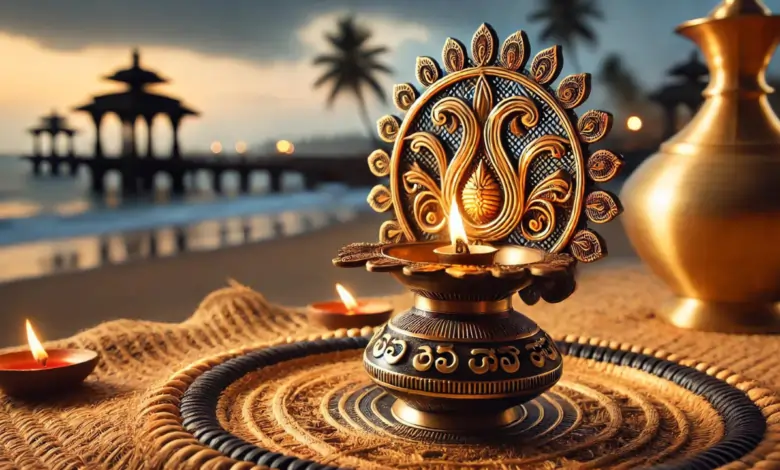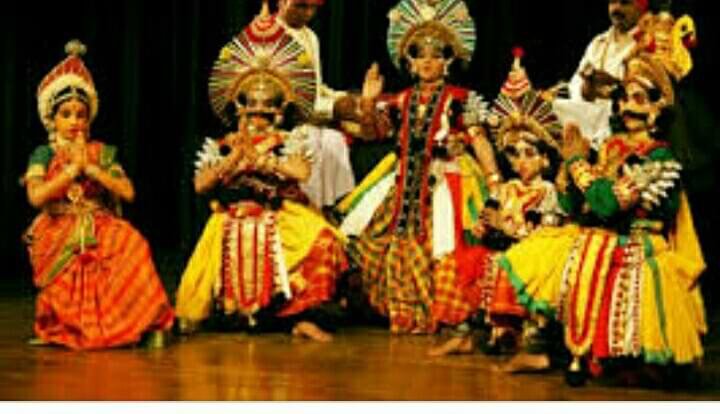Introdution
Vavilaku in Tulu culture represents an institution that is highly traditional, and associated with religious significance. The Tulu speaking people are mainly natives of the southwestern region of India, particularly the state of Karnataka, as well as a part of Kerala, and over time have maintained several customs and important rituals that identify their heritage. Explains that the use of Vavilaku takes pride in being not only a source of material light but also a source of spiritual light. This article attempts to analyze the multifaceted aspects of vavilaku in Tulu society in cultural, religious, and social contexts.
Historical background and significance
The story of vavilaku’s autonomy in Tulu culture is as ancient as the community itself. In the past, Vavilaku in Tulu also known as an oil lamp was used in homes for grand puja and rituals on the occasions of Abhishekam. It would be wrong to think of these lamps as just light. These lamps are considered auspicious because they symbolize fire, one of the five elements that make up the universe according to Hindu tradition or Pancha Mahabharata. The lights used to light the vavilaku in Tulu are said to drive away evil spirits as well as increase luck and prosperity.
Cultural practices including vavilaku
Vavilaku in Tulu is an integral part of many rituals and ceremonies in Tulu culture. On occasions like Deepavali, the festival of lights, many households in Tulu speaking areas light many oil lamps and fill their homes with light and beauty. This structure is also common in other ceremonial uses such as weddings, pujas, and other events where a row of vavilakus in Tulu is placed in a highly artistic design, especially before the altar or the entrance to the place of worship.
The Spiritual Power of Light: Vavilaku’s Role in Rituals and Celebrations
In Tulu culture, the vavilaku is not limited to being an object of light but also signifies a source of divine knowledge. In ceremonies like Abhishekam and even in festivals like Deepavali, the light of Vailaku is considered to dispel darkness and provide divine light. Thus, the inclusion of vavilaku in events such as weddings or grand festivals creates a better connection with the Tulu culture in the event.
Daily rituals
Wavilaku is lit in a Tulu house because every Tulu house has a prayer corner and Wavilaku is lit in the morning and evening at the time of prayer. This ritual of lighting the lamp is called “Sandhya Deepa” and what really opens up for the family members is the path or pathway to success the divine energies, as it were. That is why it is said that lighting a lamp cleans the house and the spirituality in the ordinary life of the practitioners
Festivals and events
Also, during major Tulu festivals, vavilaku in Tulu activities reach a whole new level. For example, during the Karvali Utsav, a grand carnival dedicated to the coastal Tulu culture of southern Karnataka, the Vavilaku in Tulu is used not only as a source of light but also as a dance and theater ornament. Lamps are incorporated into artist performances and the light given is used to narrate popular myths and legends.
Symbolic Interpretations of Vavilaku
vavilaku in Tulu is used symbolically in Tulu culture. In many cases, this concept is associated with the process of the elimination of ignorance identified with darkness and the introduction of knowledge identified with light. The oil in the lamp means the evil that is in humans and the lamp is the soul of man. Lighting the lamp in oil also represents the act of cutting the ‘as’ behind human tendencies to liberate the soul from the cycle of birth and death.
vavilaku in modern times
At this time, when most households are mechanically lit by electrical appliances, the vavilaku in Tulu traditional oil lamp is still highly regarded in Tulu households. There are many families who consider lighting the vavilaku in Tulu on their festive occasions as a way of carrying on the traditions of their ancestors. It is also considered eco friendly, with many of them using locally grown oils and ingredients, which deepens the aesthetic sense of tradition.
Vavilaku: A Bridge Between Generations and Tradition
However, in today’s modern world where technology plays an important role in people’s lives, vavilaku is preserved timeless in Tulu homes. A cultural practice such as lighting an oil lamp shows today’s generation connecting with their ancestors. Generation after generation, these lamps are taught to young Tulu people by elders to convey a message about the spiritual and cultural essence of this art. Still living in the hours of electric light, Vavelako gives the impression of being personal, eco-friendly, and timeless.
Challenges and protection
Difficulties are encountered in the practice of traditional vavilaku in Tulu among the youth as the practice is not familiar to them. However cultural conservationists and elders are also trying their best to preserve such traditions by providing proper information to the youth about the significance and symbolism of such artifacts.
Bringing Tradition to Life: Youth Practices in Wawelaku
In our study, we also learned that the Vavilaku tradition is unpopular among the younger generation in the Tulu-speaking community of Karnataka. However, there are growing movements that aim to restore this cultural paradigm through the process of imparting information to the younger generation. Efforts are now being made by cultural authorities and families to exhibit vavilaku in festivals and events and even in general activities. As for all the ecological and religious benefits mentioned above, the goal of these initiatives is to preserve this valuable tradition for generations.
Conclusion
It is therefore not mere tradition, but linking vavilaku’s existence with Tulu culture, spirituality, history, and identity that defines their existence today. In this way, vavilaku’s light continues to burn as the world of modernity moves forward, creating hope and questioning ways to preserve cultural and spiritual experiences in the developing world. This means that by accepting and knowing these old traditions, we not only remember the generation of our grandparents but also bring value and connection to the current generation.
FAQs
What is Vavilaku?
Wavilakus were traditional oil lamps that were prominently used during various rituals and daily prayers in Talunadu.
In Tulu culture, why is vavilaku in Tulu important?
Vavilaku in Tulu stands for the social manifestation of the process of removing darkness from within and bringing light into Tulu life, with active participation in social life, both religious and non-religious.
In what ways is vavilaku in Tulu involved in today’s events?
Even now, the art of making vavilaku in Tulu is widely used for weddings and other events and festivals as it has a lot of importance in Shab-e-Barat as well as the shape it gives when it is prepared.
Has there been any attempt to continue the tradition of vavilaku in Tulu?
Of course, cultural and local authorities are working to popularize vavilaku in Tulu among the youth to keep the tradition alive.

